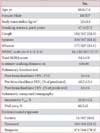Abstract
Background
Methods
Results
Figures and Tables
Table 1

Values are presented as mean±standard deviation or number (%) unless otherwise indicated.
COPD: chronic obstructive pulmonary disease; MMRC scale: modified Medical Research Council dyspnea scale; SGRQ: St George's Respiratory Questionnaire; FEV1: forced expiratory volume in 1 second; FVC: forced vital capacity; V950: volume fraction (%) of the lung below -950 HU.
Wall area (%)=wall area/(wall area+lumen area)×100.
Table 2

Values are presented as mean (%) or mean±standard deviation unless otherwise indicated.
MMRC scale: modified Medical Research Council dyspnea scale; SGRQ: St George's Respiratory Questionnaire; FEV1: forced expiratory volume in 1 second; V950: volume fraction (%) of the lung below -950 HU.
Wall area (%)=wall area/(wall area+lumen area)×100.
Table 3

Values are presented as mean (%) or mean±standard deviation unless otherwise indicated.
MMRC scale: modified Medical Research Council dyspnea scale; SGRQ: St George's Respiratory Questionnaire; FEV1: forced expiratory volume in 1 second; V950: volume fraction (%) of the lung below -950 HU.
Wall area (%)=wall area/(wall area+lumen area)×100.
Table 4

Values are presented as mean (%) or mean±standard deviation unless otherwise indicated.
BMI: body mass index; MMRC scale: modified Medical Research Council dyspnea scale; SGRQ: St George's Respiratory Questionnaire; FEV1: forced expiratory volume in 1 second; V950: volume fraction (%) of the lung below -950 HU.
Wall area (%)=wall area/(wall area+lumen area)×100.
Table 5

Values are presented as mean (%) or mean±standard deviation unless otherwise indicated.
BMI: body mass index; MMRC scale: modified Medical Research Council dyspnea scale; SGRQ: St George's Respiratory Questionnaire; FEV1: forced expiratory volume in 1 second; V950: volume fraction (%) of the lung below -950 HU.
Wall area (%)=wall area/(wall area+lumen area)×100.




 PDF
PDF ePub
ePub Citation
Citation Print
Print



 XML Download
XML Download